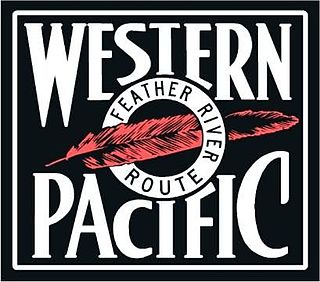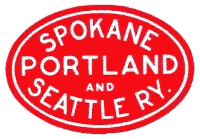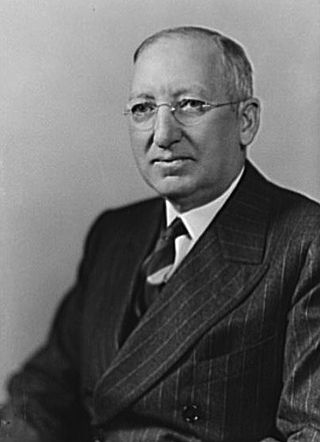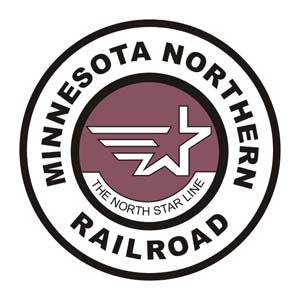
The Great Northern Railway was an American Class I railroad. Running from Saint Paul, Minnesota, to Seattle, Washington, it was the creation of 19th-century railroad entrepreneur James J. Hill and was developed from the Saint Paul & Pacific Railroad. The Great Northern's route was the northernmost transcontinental railroad route in the U.S.

BNSF Railway is the largest freight railroad in the United States. One of six North American Class I railroads, BNSF has 36,000 employees, 33,400 miles (53,800 km) of track in 28 states, and over 8,000 locomotives. It has three transcontinental routes that provide rail connections between the western and eastern United States. BNSF trains traveled over 169 million miles in 2010, more than any other North American railroad.

The Burlington Northern Railroad was a United States-based railroad company formed from a merger of four major U.S. railroads. Burlington Northern operated between 1970 and 1995.

The Coast Starlight is a long-distance passenger train operated by Amtrak on the West Coast of the United States between Seattle and Los Angeles via Portland and the San Francisco Bay Area. The train, which has operated continuously since Amtrak's formation in 1971, was the first to offer direct service between Seattle and Los Angeles. Its name is a combination of two prior Southern Pacific (SP) trains, the Coast Daylight and the Starlight.

The Western Pacific Railroad was a Class I railroad in the United States. It was formed in 1903 as an attempt to break the near-monopoly the Southern Pacific Railroad had on rail service into northern California. WP's Feather River Route directly competed with SP's portion of the Overland Route for rail traffic between Salt Lake City/Ogden, Utah, and Oakland, California, for nearly 80 years. The Western Pacific was one of the original operators of the California Zephyr passenger line.

The Spokane, Portland & Seattle Railway was a railroad in the northwest United States. Incorporated in 1905, it was a joint venture by the Great Northern Railway and the Northern Pacific Railway to build a railroad along the north bank of the Columbia River. The railroad later built or acquired other routes in Oregon. The SP&S was merged into the Burlington Northern in March, 1970. Remnants of the line are currently operated by BNSF Railway and the Portland and Western Railroad.

Ralph Budd was an American railroad executive who was the president of the Great Northern Railway from 1919 up until 1932, when he served as president of the Chicago, Burlington and Quincy Railroad until his retirement in 1949.

The Keddie Wye is a railroad junction in the form of a wye on the Union Pacific Railroad in Plumas County, California, United States. Located at the town of Keddie, it joins the east-west Feather River Route and the "Inside Gateway"—formally, the BNSF Gateway Subdivision—which runs north to Bieber.
Burlington Northern Santa Fe Manitoba is a Canadian subsidiary railroad of the BNSF Railway, which operates in Winnipeg, Manitoba.

The Minnesota Northern Railroad is a Class III shortline railroad that operates over 224 miles (360 km) of track in northwestern Minnesota. The railroad is co-owned by KBN Incorporated and Independent Locomotive Service and is headquartered in Crookston, Minnesota.

The Northern Transcon, a route operated by the BNSF Railway, traverses the most northerly route of any railroad in the western United States. This route was originally part of the Chicago, Burlington and Quincy Railroad, Northern Pacific Railway, Great Northern Railway and Spokane, Portland and Seattle Railway systems, merged into the Burlington Northern Railroad system in 1970.

Burlington Northern Railroad Bridge 9.6 or BNSF Railway Bridge 9.6, also known as the Columbia River Railroad Bridge, is through truss railway bridge across the Columbia River, between Portland, Oregon, and Vancouver, Washington, owned and operated by BNSF Railway. Built by the Spokane, Portland and Seattle Railway (SP&S) and completed in 1908, it was the first bridge of any kind to be built across the lower Columbia River, preceding the first road bridge, the nearby Interstate Bridge, by a little more than eight years.
Rail transportation is an important element of the transportation network in the U.S. state of Oregon. Rail transportation has existed in Oregon in some form since 1855, and the state was a pioneer in development of electric railway systems. While the automobile has displaced many uses of rail in the state, rail remains a key means of moving passengers and freight, both within the state and to points beyond its borders.
The following is a brief history of the North American rail system, mainly through major changes to Class I railroads, the largest class by operating revenue.

The Oregon Slough Railroad Bridge, also known as the BNSF Railway Bridge 8.8, is a swing-span, through truss bridge in Portland, Oregon, United States. Currently owned and operated by BNSF Railway, it crosses an anabranch of the Columbia River known as North Portland Harbor and historically as the Oregon Slough. The bridge's northern end is on Hayden Island, which, along with Tomahawk Island, forms the north shore of the channel. Completed in 1908, the two-track bridge is one of only two swing bridges surviving in Portland, which once had several bridges of that type, both for road and rail traffic. The only other remaining swing bridge in the Portland area is another rail-only bridge on the same line, BNSF's nearby Bridge 9.6, spanning the Columbia River.
The Cameron connector is a section of track built in 1995–1996 which connects the former Burlington Northern Railroad and the former Atchison, Topeka and Santa Fe Railway tracks, both which are now part of the BNSF Railway, to each other near Cameron, Illinois.
The Brainerd Subdivision is a rail line owned and operated by BNSF Railway. It runs from Staples, Minnesota where it connects with the Staples Subdivision to Carlton, Minnesota and the Lakes Subdivision, about 150 miles (240 km) in length.
Barstow Yard is a classification yard operated by Burlington Northern Santa Fe Railway (BNSF) in Barstow, California. With 48 directional tracks and a total area of approximately 600 acres (240 ha), it is the second largest classification yard west of the Rocky Mountains after the JR Davis Yard. Today, almost all freight traffic to and from Southern California runs through the junction.

The Colorado Joint Line is a railway corridor in Colorado running north-south between Denver and Pueblo. Presently the tracks are owned by the BNSF Railway and the Union Pacific Railroad and operated jointly.












